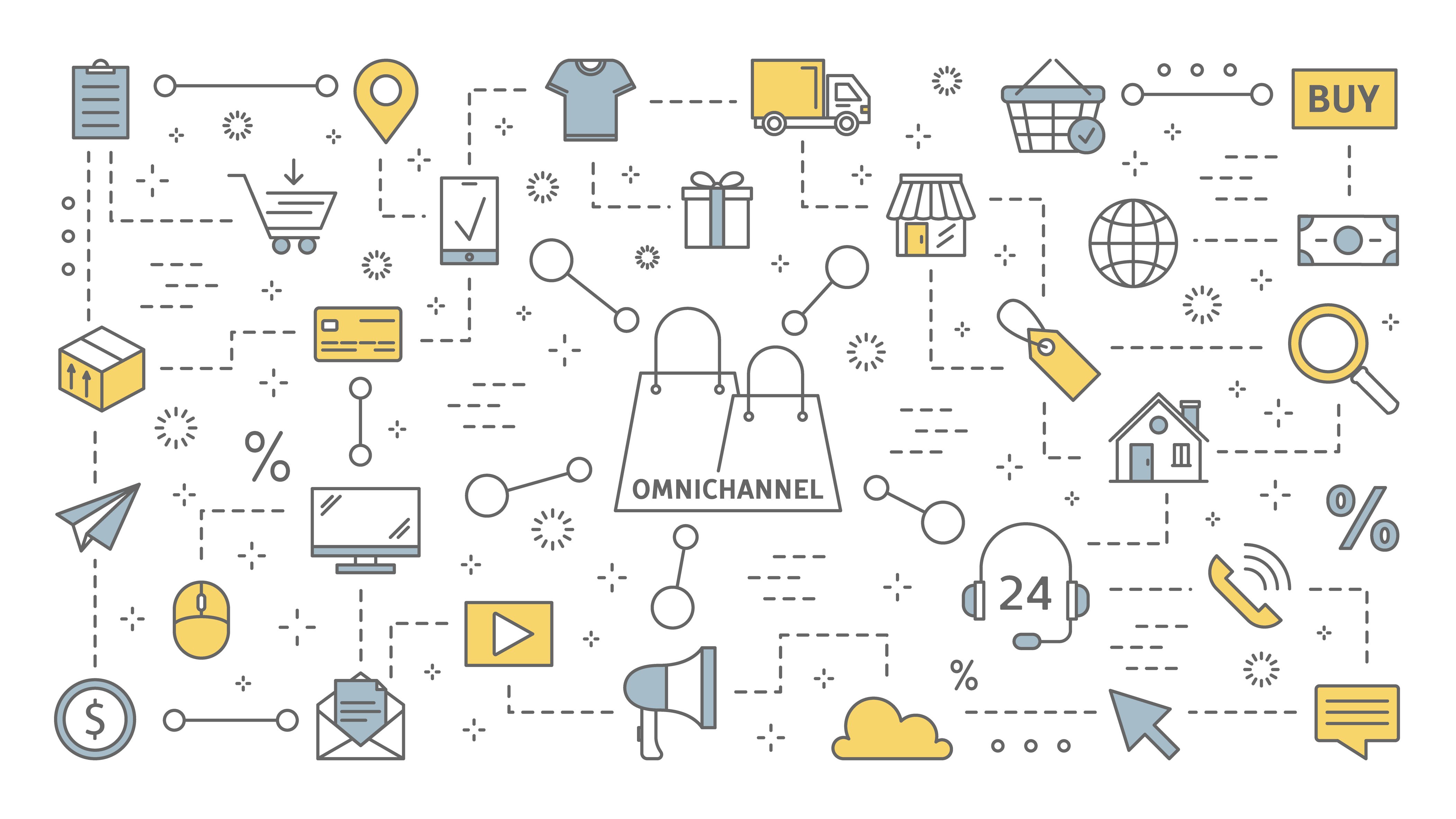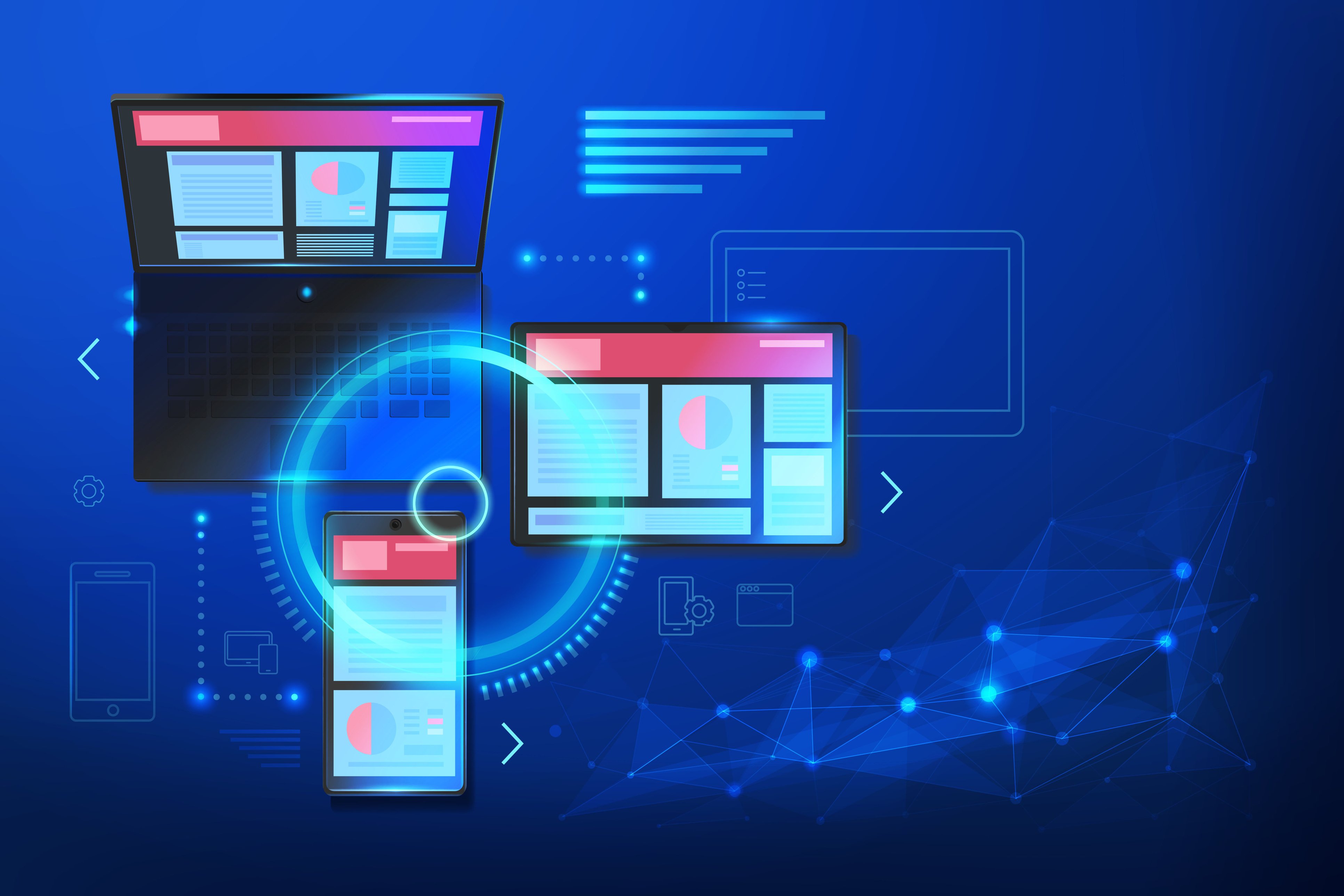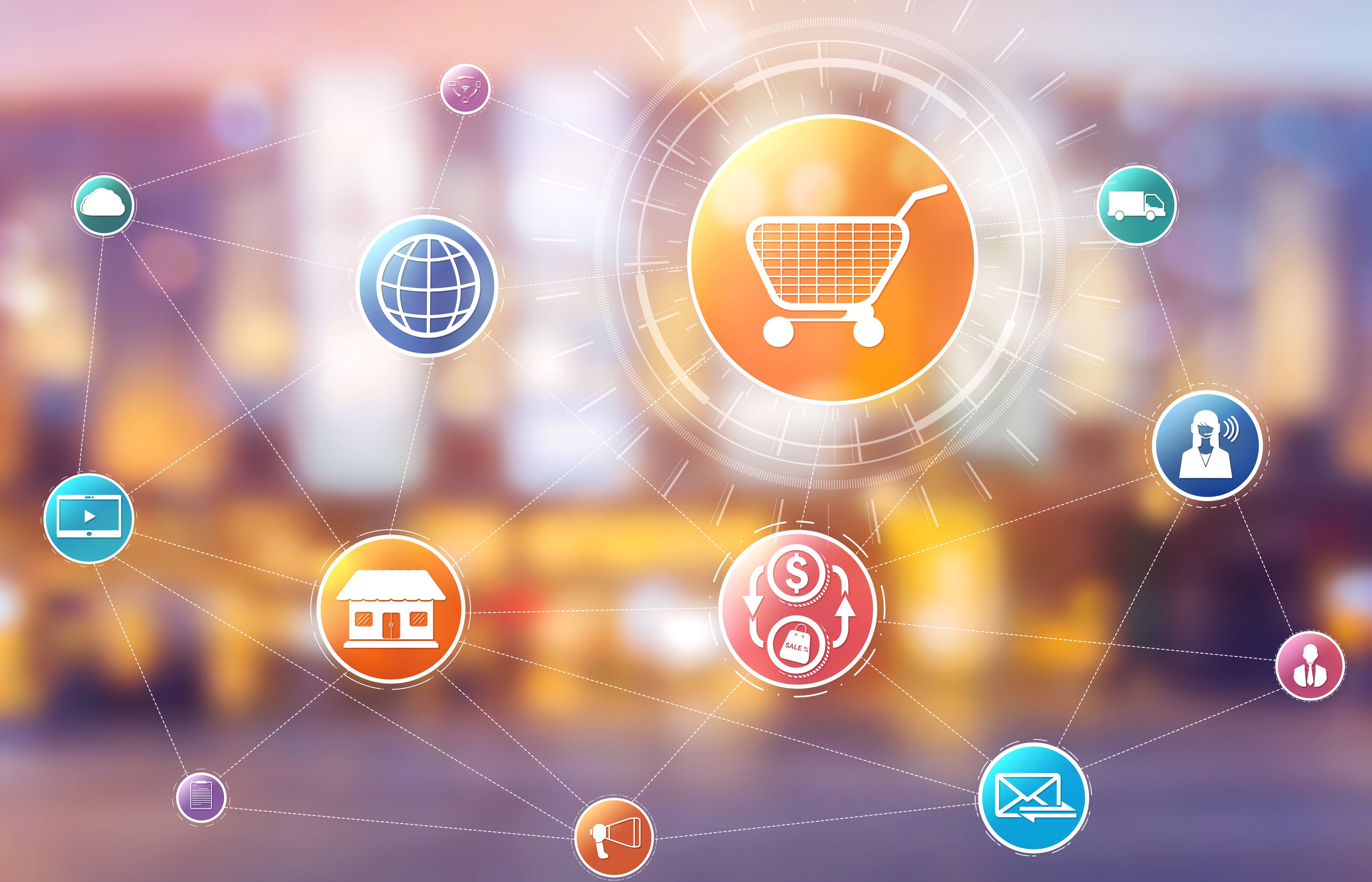
What is Omnichannel Retailing?
Omnichannel retailing is a fully integrated approach to commerce that provides shoppers with a unified experience across online and offline channels.
True omnichannel commerce extends from brick-and-mortar locations to mobile browsing, eCommerce marketplaces, onsite storefronts, social media, retargeting, and everything in between.
Key features of omnichannel strategies in retail include:
- Consistency: Ensures a uniform customer experience across all platforms and interaction points, both online and offline.
- Seamlessness: Eliminates boundaries between selling channels, providing a fluid, integrated customer journey.
- Personalization: Uses data to offer tailored shopping experiences, aligning with customer preferences and behaviors.
- Integration: Combines processes, channels, and customer data to facilitate a cohesive and unified shopping experience.
- Centricity: Focuses on delivering a superior, customized experience at every touchpoint, always putting the customer first.
The Need for Omnichannel Retail Solutions
Today, customers expect – and demand – the same level of service regardless of where or how they shop.
Omnichannel retail strategies prioritize customer relationships and provide a seamless shopping experience whether customers visit physical stores or engage with brands on any online sales channel.
While businesses can significantly boost their revenue with an omnichannel retail strategy, failing to do so can seriously impair sales potential.
Retailers can optimize their existing omnichannel strategy by understanding customer journeys and preparing personalized experiences.
Industry research shows that 73% of customers prefer shopping through multiple channels. Through omnichannel strategies, each cross-channel touchpoint provides customers with a unified experience they can easily engage.
Companies with a solid omnichannel retail strategy retain an average of 89% of their customers compared to 33% for companies with less established omnichannel strategies.
Studies have also shown that omnichannel shoppers spend more in the long term, with greater transaction size and CLV (customer lifetime value).
Omnichannel Retail Examples

Modern retail omnichannel strategies may include multiple contact channels, such as app-based platforms, in-store purchases, and social media marketplaces. For instance, a consumer electronics company may engage audiences via their official eCommerce site and in-store POS (point of sale) while providing a seamless shopping experience.
2022 brings added marketing challenges, as many brands are now prioritizing an omnichannel approach for their physical store and online channels. On top of that, big names across various industries have successfully implemented omnichannel strategies over the years.
For example, Target has partnered with social media site Pinterest to provide customers with an interactive visual browsing experience. Similarly, Disney has successfully integrated an omnichannel strategy via its My Disney Experience application, which seamlessly guides visitors through the services offered across their theme parks while maintaining consistent branding.
Omnichannel Retail Trends & How to Refine Your Strategy

Market research predicts that the eCommerce industry could grow by almost $11 trillion between 2021 and 2025. The emerging trend highlights the importance of omnichannel approaches to marketing for retail companies as more customers adapt to seamless shopping practices.
The Rise of BOPIS, Curbside, and Similar Options
BOPIS (buy online pick up in store) has become increasingly popular among modern customers. Through BOPIS, customers can skip long delivery times and avoid costly shipping costs while enjoying the convenience of online shopping channels. BOPIS also offers a hybrid process that has gained traction, as more shoppers opt for flexible brand experiences.
The benefits of BOPIS facilitate faster checkouts and product collection, with industry research showing a 35% increase in sales during the holiday season. With these numbers, BOPIS remains an integral part of the eCommerce industry, giving customers more control and personalization over their transactions.
Companies can effectively roll out BOPIS services by providing customers with automated confirmation emails for product collection and refining communication processes for a seamless pickup experience. For example, companies should feature a responsive inventory system informing customers about unavailable products and offering user-friendly navigation across apps and websites.
Similarly, brands may also offer other purchase policies that further expand on the flexibility of customer experiences. These shopper options may include ROPIS (reserve online pick up in-store), BORIS (buy online return in-store), and curbside pickup services, which can improve an existing omnichannel retail strategy.
Virtual Shopping Experiences & AR Integration
.jpg?width=3864&name=iStock-1312231371%20(1).jpg)
Virtual shopping experiences allow customers to browse and access goods and services via an online platform. Essentially, the virtual process enables customers to connect with a sales or brand representative in real-time, similar to in-store shopping experiences. The addition of virtual experiences can help optimize a brand's omnichannel strategy.
Additionally, advanced virtual shopping experiences feature digital methods of testing and previewing a product before purchase.
Brands achieve the process via the latest AR and VR technologies, which allow customers to superimpose products in reality for comparison. These digital features can significantly improve omnichannel strategies, with market reports stating that 71% of shoppers would frequent stores that present AR technology.
Brands can optimize their virtual shopping offerings by leveraging multiple communication methods, including social media chats, chatbots, and text messaging. Under such arrangements, brands must assign dedicated service staff to each endpoint, maintaining an undisrupted customer connection.
Virtual shopping offerings may also include dynamic video tailored to customer preferences, replacing static text and photos with interactive content that recreates immersive in-store experiences.
Essentially, a well-structured virtual shopping infrastructure enhances a brand’s omnichannel strategies, offering human assistance that can help support a purchase decision while potentially reducing the prevalent risks of cart abandonment.
With 58% of modern retail influenced by digital advances, virtual shopping on websites, mobile apps, and even in-store has proven highly advantageous for brands to bridge the gap between a brick and mortar and online customer engagement.
AI & Machine Learning Enhancements
AI and machine learning are not future trends; they are present-day necessities. Retailers leveraging these technologies are not just staying competitive but setting new standards in customer experience, operational efficiency, and retail innovation.
Heading into 2024, integrating AI and machine learning will be a defining factor separating market leaders from the rest in the omnichannel retail space.
Here’s how AI can be leveraged to create impactful omnichannel experiences:
- Customer Personalization: Utilizing AI to tailor product recommendations, content, and marketing messages for individual customers, enhancing the overall shopping experience.
- Demand Forecasting: Employing machine learning to predict product demand, helping retailers optimize stock levels, reduce excess inventory, and minimize stockouts.
- Automated Customer Service: Using AI-driven chatbots and virtual assistants to provide instant, 24/7 customer support, resolving issues and answering queries efficiently.
- Visual Search: Implementing AI-powered visual search to allow customers to use images to find and buy products, ensuring a more intuitive and engaging shopping experience.
- Dynamic Pricing: Leveraging machine learning to adjust prices in real-time based on various factors like demand, competitor prices, and inventory levels, maximizing profitability and competitiveness.
Apply Essential Customer Data Across the Business

While most brands integrate customer data in their personalized online strategies, they may lack the same system for offline experiences. Applying measurable customer data throughout the omnichannel retail strategy gives businesses a comprehensive view of shopper behavior, driving seamless engagement and customer loyalty according to core purchasing practices.
For example, say a customer places an order online for multiple items, gaining loyalty points for the entire order. They then decide to return one of those items to a retail store. As the retailer, you need to be able to 1) make a seamless return in-store and 2) be able to remove any loyalty points earned by the item returned.
You also need to be able to record every touchpoint, regardless of where it occurred. This provides a more comprehensive picture of customer interactions, which can be used to improve the overall shopping experience.
Sustainability as a Priority
Consumers are increasingly conscious of the environmental impact of their purchases and are aligning themselves with brands that prioritize eco-friendly practices.
This trend is manifesting in several innovative ways in omnichannel retail.
- Eco-Friendly Packaging: Adoption of recyclable and recycled materials and minimalistic design to reduce waste.
- Sustainable Supply Chains: Enhanced transparency and ethically sourced, environmentally friendly supply chains enabled by technologies like blockchain.
- Circular Economy: Introduction of recycling and upcycling programs, incentivizing customers to return used items.
- Carbon Neutral Operations: Efforts to achieve carbon neutrality through optimized logistics, renewable energy, and environmental initiatives.
- Eco-Friendly Products: Expansion of inventories to include products made with sustainable materials and ethical practices.
- Digital Integration: Shift to paperless solutions like digital receipts and e-catalogs to reduce physical waste.
- Green Delivery Options: Incorporation of eco-friendly delivery methods, including bicycle couriers and electric vehicle fleets.
Keeping All Inventory Data Points Synced

An efficient omnichannel strategy ensures every data point remains consistent across inventories. Poorly synced inventory could lead to lost sales, affecting a brand's overall revenue. For instance, some customers may exclusively consult their smartphone apps for product stock and may miss out on in-store inventory.
Therefore, retailers need to monitor that each inventory touchpoint syncs in real-time from a centralized monitoring system for an optimized omnichannel retail strategy. Aside from providing accurate product quantities, each touchpoint should offer valuable data, such as restocking timelines and push notification alerts.
Customers should also be able to see when out-of-stock items will be back in stock or preorder any new items, right from a retailer’s online storefront. This information should also be available for associates at physical stores to answer customer queries more easily.
Implementing an Order Management System (OMS) for Omni Channel Success

An advanced order management system (OMS) equips businesses with critical one-stop capabilities to fulfill omnichannel demands at scale. Through a trusted OMS, retailers can streamline every aspect of order management, optimizing omnichannel experiences at each touchpoint.
An OMS is critical for executing omnichannel strategies to keep everything in sync across all of your sales channels and provide a superior customer experience that creates loyalty.
Here are five ways an OMS can streamline your omnichannel strategy:
1. Centralized view of all inventory
Allocate inventory where needed for a seamless experience. Multiple channels can pull from the same inventory pool or you can segment inventory for specific omnichannel retail channels. You can also showcase local store inventory on your website so customers know it’s available at your brick-and-mortar store.
This blends the online and offline shopping experience so that customers can shop the way they want with multiple options. At the same time, you can worry less about stockouts or inaccurate inventory counts.
2. Omnichannel fulfillment options
The customer experience in today’s eCommerce environment should also allow more personalized experiences by providing multiple customer service options as part of your marketing strategy. To be competitive today, your retail strategy should include:
- BOPIS (Buy Online, Pick Up in Store)
- ROPIS (Reserve Online, Pick Up in Store)
- BOSS (Buy Online, Ship from Store)
- BODFS (Buy Online, Deliver from Store)
- Curbside pickup
3. Flexible returns process
You should also offer multiple channels for handling returns, including:
- Self-service returns
- BORIS (Buy Online, Return in Store)
48% of consumers say cross-channel returns such as BORIS are important options. BORIS can simplify returns for shoppers and also provide another reason for them to visit and be immersed in the store experience.
However, you must have a robust OMS solution in place to manage returns effectively. Adding self-service options can significantly reduce the workload and provide a better customer experience.
4. Customer notifications
The right OMS can also automate customer notifications at each step of the buying journey. This helps personalize experiences and offers you an additional way to build loyalty with your customers for the long term. Not only are you providing greater transparency for your customers, but you add additional touchpoints and opportunities to upsell or cross-sell as part of your marketing campaigns.
Automating notifications for confirmations, shipping, delivery, etc. should be part of your retail strategy.
5. Offer preorders and backorders
You can gain momentum for new product launches and increase cash flow even before you have items in stock by utilizing preorders on your online channels. You can also help mitigate customer frustrations by being transparent about stockouts and letting customers know when items are likely to be available.
OMS solutions can help replace manual processes with automation, improving efficiency and consistency.
Challenges of Omnichannel Retail and the Role of an OMS
As appealing and advantageous as omnichannel is, it is not without its set of challenges.
Achieving a seamless shopping experience across multiple online and in-store platforms requires a symphony of well-orchestrated strategies, robust technology, and a customer-centric approach.
Here are some of the most common hurdles brands face in perfecting fulfillment and how omnichannel retail software like an OMS can save the day.
Integration Complexity
Reconciling data from multiple platforms - from in-store POS systems to e-commerce websites and mobile apps - is a colossal task. Without an OMS, the integration and management of these disparate systems can lead to inconsistencies, errors, and a disjointed customer experience.
Inventory Management
Real-time inventory visibility is a cornerstone of effective omnichannel retailing. It is nearly impossible to achieve without an OMS. Retailers face the risk of stockouts, overstocking, and inaccurate inventory data, leading to lost sales and diminished customer trust.
Customer Experience Consistency
An OMS is instrumental in ensuring consistency across various customer touchpoints. Without it, maintaining uniformity in service quality, brand messaging, and overall customer experience becomes a precarious balancing act, often tilting toward inconsistency.
Technology Investment
The initial technological outlay for omnichannel can be substantial and, without an OMS, can lack scalability and adaptability. An OMS ensures that the investment is not just a cost but adds tangible value, enhancing ROI and positioning the business for future growth.
Grow Revenue & Improve Omnichannel Retail Experiences with Deck Commerce
Deck Commerce is a leading OMS (order management system) that makes it convenient for DTC retailers to optimize their omnichannel efforts. The advanced software offers extensive resources for navigating the latest industry trends and insights that enable businesses to optimize the entire order lifecycle—from storefront to front door.
With more than 60 prebuilt integrations and an open API framework, Deck Commerce allows retailers to use their current tech stack, or easily swap or add technology as needed.
Request a demo with Deck Commerce to discover the most effective omnichannel tools for your business needs and eliminate the risk of lost sales today!

